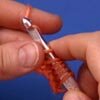
Free Crochet Patterns
See our Copyright Policy regarding NexStitch™ Articles
The Bare Bones: Crochet Stitch Anatomy 101
There's a lot more to crochet stitching than just single and double crochet. Crochet artists like to think "out of the box" and find different ways to hook the yarn to the fabric they are creating. To do this, you'll need to know the in's and out's of crochet stitch anatomy. In this article, we will discuss:
LOOPS: Let's get loopy for a moment. Each stitch that you make will create a front loop and a back loop. (I like to say they look like horseshoes, or to continue with our 'Crochet Family' analogy, they're like little feet walking in a line.) When we looked at how to create a basic crochet stitch, we inserted the hook through both loops. Sometimes you'll work up a crochet pattern that requires you to "Work In Front Loops Only,..." meaning that you'll only insert your hook through the front loop, not both. You might also see it written as, "working in bl..." The first picture shows a series of double crochet stitches in only the front loops. Notice that you can't see the back loops because they're being blocked by the sc stitches. The second picture illustrates working in the back loops only. In this case, you'll be able to see the front loops. |
||
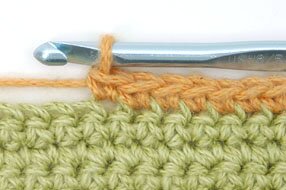 |
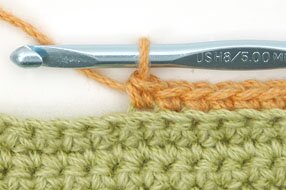 |
|
|
You might be asking yourself, "Why would I want to work in only one loop?" It's good for two reasons. First of all, working in only one loop creates a detailed edging when left on its own. (This crochet handbag pattern is a good example of working in one loop.) Another reason is that some patterns require you to create a detailed trim or edging and having that extra loop available (called a "free loop") enables a crocheter to do it. The benefit is that you can literally go back to those free loops later on and work across them! Now that you know your loops, let's look at other places to make stitches. POSTS: Using our 'Crochet Family' analogy again, each stitch has a 'body' and in crochet they are called, "posts." They are located directly below the loops we just discussed. It's like the 'body' of the stitch. In a crochet pattern, you might see them listed as "FPdc" (front post double crochet) or "BPdc" (back post double crochet) written. Making these stitches will require you to insert the hook in between the posts. The difference between the front and back post stitches is where we insert the hook. To create a FPdc stitch, wrap the yarn over your hook, insert the hook from front to back in the space before your next stitch, then insert it in the space after the next stitch, working from back to front. Basically, you're just weaving the hook through the fabric (1). Now, since this is a double crochet front post stitch, we're going to continue as though we're making a normal dc stitch (2). |
||
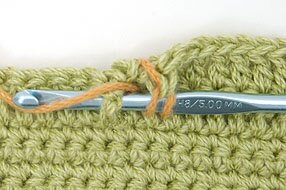 |
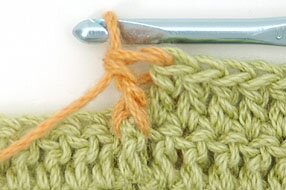 |
|
|
For the BPdc, bring the hook to the back side of the fabric, insert the hook in the space before the next stitch, then bring it over the post and insert the hook in the space after the next stitch. Now, complete the stitch as though it's a regular dc stitch. |
||
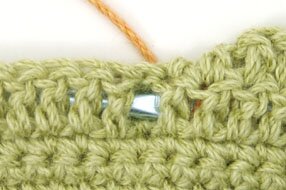 |
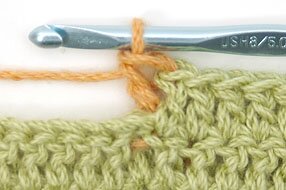 |
|
|
The benefits to working with the posts is that it creates either a raised or recessed stitch. This type of stitching is most often found in projects that feature intricate cable patterns.
SPACES: This is another creative place to make a stitch. Spaces are made several different ways. In the first example below, the space was created from a chain stitch worked in between the regular single crochet stitches. In a pattern, you might be asked to "SC in the next ch-2 sp," meaning you'll place a single crochet stitch in the next chain-two space that was created in the previous row. Chain spaces can be found in patterns that are what is called, "openwork" meaning a pattern with many open areas which is comprised of a lacey pattern or motif such as this crochet shawl pattern. A pattern might also call on you to create a stitch in the next available space, but perhaps the pattern you are working on is not a lacey one. "Where do I put that stitch?" you might ask. Well, it will go in between the next two posts, but not through the loops. "Why would I want to put a stitch there? Won't that make my rows uneven on the ends?" you're probably wondering. These kinds of patterns have stitches that line up more like bowling pins in a bowling alley as opposed to classroom desks in rows. The answer is that some patterns are intentionally designed that way, particularly those which feature rows of varying colors where the emphasis is placed on the interchanging colors, and not the uniformity of the stitches. |
||
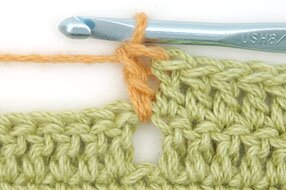 |
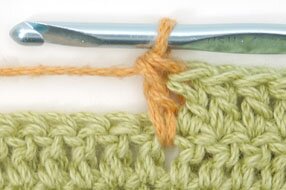 |
|
|
Now that you know a little more about where you can place stitches, let's look at how to read a crochet pattern and decode what can be very confusing crochet language. |
||
<< Return to Articles Main Page >>
mailing list
site map

